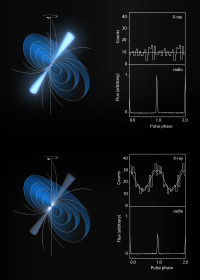Baffling pulsar leaves astronomers in the dark
24 January 2013
New observations of a highly variable pulsar using ESA's XMM-Newton are perplexing astronomers. Monitoring this pulsar simultaneously in X-rays and radio waves, astronomers have revealed that this source, whose radio emission is known to 'switch on and off' periodically, exhibits the same behaviour, but in reverse, when observed at X-ray wavelengths. It is the first time that a switching X-ray emission has been detected from a pulsar, and the properties of this emission are unexpectedly puzzling. As no current model is able to explain this switching behaviour, which occurs within only a few seconds, these observations have reopened the debate about the physical mechanisms powering the emission from pulsars.
 |
|
Artist's impression of a pulsar in radio-bright mode. Credit: ESA/ATG medialab |
Few classes of astronomical objects are as baffling as pulsars – which were discovered as flickering sources of radio waves and soon after interpreted as rapidly rotating and strongly magnetised neutron stars. Even though about 2000 pulsars have been found since the first was discovered in 1967, a detailed understanding of the mechanisms that power them still eludes astronomers.
"There is a general agreement about the origin of the radio emission from pulsars: it is caused by highly energetic electrons, positrons and ions moving along the field lines of the pulsar's magnetic field, and we see it pulsate because the rotation and magnetic axes are misaligned," explains Wim Hermsen from SRON, the Netherlands Institute for Space Research in Utrecht, The Netherlands. "How exactly the particles are stripped off the neutron star's surface and accelerated to such high energy, however, is still largely unclear," he adds.
Hermsen led a new study based on observations of the pulsar known as PSR B0943+10, which were performed simultaneously in X-rays, with ESA's XMM-Newton, and in radio waves. By probing the emission from the pulsar at different wavelengths, the study had been designed to discern which of various possible physical processes take place in the vicinity of the magnetic poles of pulsars. Instead of narrowing down the possible mechanisms suggested by theory, however, the results of Hermsen's observing campaign challenge all existing models for pulsar emission, reopening the question of how these intriguing sources are powered.
"Many pulsars have a rather erratic behaviour: in the space of a few seconds, their emission becomes weaker or even disappears for a while, just to go back to the previous level after some hours," says Hermsen. "We do not know what causes such a switch, but the fact that the pulsar keeps memory of its previous state and goes back to it suggests that it must be something fundamental."
Recent studies indicate that the switch between what are usually referred to as 'radio-bright' and 'radio-quiet' states is correlated to the pulsar's dynamics. As pulsars rotate, their spinning period slows down gradually, and in some cases the slow-down process has been observed to accelerate and slow down again, in conjunction with the pulsar switching between radio-bright and quiet states. The existence of correlated variations in both the rotation and emission suggest a connection between a pulsar's immediate vicinity and, on a grander scale, its co-rotating magnetosphere, which may extend up to about
"Since the switch between a pulsar's bright and quiet states links phenomena that occur on local and global scales, a thorough understanding of this process could clarify several aspects of pulsar physics. Unfortunately, we have not yet been able to explain it," says Hermsen.
 |
| Artist's impression of a pulsar in X-ray-bright/radio-quiet mode. Credit: ESA/ATG medialab |
Hermsen and his colleagues planned to search for an analogous pattern at a different wavelength – in X-rays – to investigate what causes this switching behaviour. They chose as their subject PSR B0943+10, a pulsar that is well known for its switching behaviour at radio wavelengths and for its X-ray emission, which is brighter than might be expected for its age.
"Young pulsars shine brightly in X-rays because the surface of the neutron star is still very hot. But PSR B0943+10 is five million years old, which is relatively old for a pulsar: the neutron star's surface has cooled down by then," explains Hermsen.
Astronomers know of only a handful of old pulsars that shine in X-rays and believe that this emission comes from the magnetic poles – the sites on the neutron star's surface where the acceleration of charged particles is triggered. "We think that, from the polar caps, accelerated particles either move outwards to the magnetosphere, where they produce radio emission, or inwards, bombarding the polar caps and creating X-ray emitting hot-spots," Hermsen adds.
There are two main models that describe these processes, depending on whether the electric and magnetic fields at play allow charged particles to escape freely from the neutron star's surface. In both cases, it is believed that the emission of X-rays follows that of radio waves, but the emission that is observed in each scenario is characterised by different temporal and spectral characteristics. Monitoring the pulsar in X-rays and radio waves at the same time, the astronomers hoped to be able to discern between the two models.
Obtaining observing time on the requested telescopes turned out to be a rather lengthy procedure. "We needed very long observations, to be sure that we would record the pulsar switching back and forth between bright and quiet states several times," says Hermsen, "So we asked for a total of 36 hours of observation with XMM-Newton. This is quite a lot of time, and it took us five years before our proposal was accepted."
 |
| The two states of pulsar PSR B0943+10 as observed with XMM-Newton and LOFAR. Credit: ESA/ATG medialab; ESA/XMM-Newton; ASTRON/LOFAR |
The observations were performed in late 2011. The X-ray monitoring performed with XMM-Newton was accompanied by simultaneous observations at radio waves from the Giant Metrewave Radio Telescope (GMRT) in India and the recently inaugurated Low Frequency Array (LOFAR) in the Netherlands, which was used during its commissioning phase, while testing its science operations.
"The X-ray emission of pulsar PSR B0943+10 beautifully mirrors the switches that are seen at radio wavelengths but, to our surprise, the correlation between these two emissions appears to be inverse: when the source is at its brightest in radio waves, it reaches its faintest in X-rays, and vice versa," says Hermsen.
The XMM-Newton data also show that the source pulsates in X-rays only during the X-ray-bright phase – which corresponds to the quiet state at radio wavelengths. During this phase, the X-ray emission appears to be the sum of two components: a pulsating component consisting of thermal X-rays, which is seen to switch off during the X-ray-quiet phase, and a persistent one consisting of non-thermal X-rays. Neither of the leading models for pulsar emission predicts such behaviour.
"The data collected during our monitoring campaign are truly challenging our understanding of pulsars, since no current model is able to explain them," comments Hermsen. "In the second half of 2013, we plan to repeat the same study for another pulsar, PSR B1822-09, which exhibits similar radio emission properties, but is characterised by a different geometrical configuration. This will allow us to study these extreme objects under different viewing angles," he adds.
In the meantime, these observations will keep theoretical astrophysicists busy investigating possible physical mechanisms that could cause the sudden and drastic changes to the pulsar's entire magnetosphere and result in such a curious emission.
"The unpredictable behaviour of this pulsar, revealed using the great sensitivity of the telescopes on board XMM-Newton, may require a radically new approach to study the fundamental processes that power these fascinating objects," comments Norbert Schartel, XMM-Newton Project Scientist at ESA.
Notes for editors
The study presented here is based on X-ray observations of pulsar PSR B0943+10 performed with ESA's XMM-Newton between 4 November and 4 December 2011. These observations consisted of six observations in the energy range between 0.2 and 10 keV, each lasting six hours. The X-ray data were gathered at the same time as observations at radio wavelengths performed with the Indian Giant Metrewave Radio Telescope (GMRT) at 320 MHz and the international Low Frequency Array (LOFAR) at 140 MHz.
The research was led by Wim Hermsen (SRON Netherlands Institute for Space Research and Astronomical Institute 'Anton Pannekoek', University of Amsterdam), Lucien Kuiper and Jelle de Plaa (SRON Netherlands Institute for Space Research), Jason Hessels and Joeri van Leeuwen (ASTRON and Astronomical Institute 'Anton Pannekoek', University of Amsterdam), Dipanjan Mitra and Rahul Basu (NCFRA-TIFR, Pune, India), Joanna Rankin (University of Vermont, Burlington, USA), Ben Stappers (University of Manchester, UK), and Geoffrey Wright (University of Sussex, UK). The Pulsar Working Group and the Builders Group from the LOFAR-telescope, which was at the time in the commissioning phase, supported the observations.
The European Space Agency's X-ray Multi-Mirror Mission, XMM-Newton, was launched in December 1999. It is the biggest scientific satellite to have been built in Europe and uses over 170 wafer-thin cylindrical mirrors spread over three high throughput X-ray telescopes. Its mirrors are among the most powerful ever developed. XMM-Newton's orbit takes it almost a third of the way to the Moon, allowing for long, uninterrupted views of celestial objects. The scientific community can apply for observing time on XMM-Newton on a competitive basis.
Related publications
W. Hermsen, et al., "Synchronous X-ray and Radio Mode Switches: a Rapid Global Transformation of the Pulsar Magnetosphere", 2013, Science, 339, 6118, 436-439, DOI:10.1126/science.1230960
Contacts
Wim Hermsen
SRON Netherlands Institute for Space Research
Utrecht, The Netherlands
and Astronomical Institute 'Anton Pannekoek'
University of Amsterdam, The Netherlands
Email: w.hermsen![]() sron.nl
sron.nl
Phone: +31-88-7775871; +31-614547929
Norbert Schartel
ESA XMM-Newton Project Scientist
Directorate of Science and Robotic Exploration
European Space Agency
Email: Norbert.Schartel![]() esa.int
esa.int
Phone: +34-91-8131-184



